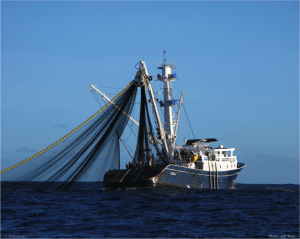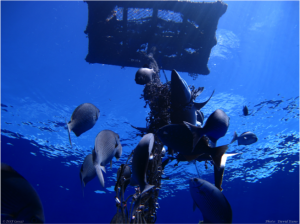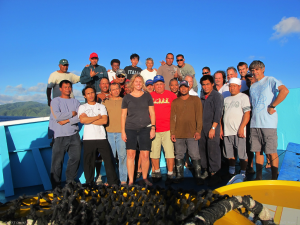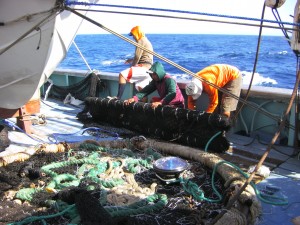Posted December 11, 2014
By DOMENICA A. LEONE
Purse seine fishing vessels catch nearly 65 percent of the 4.4 million tons of tuna caught globally every year. These vessels operate in different ways depending on the fleet, the area, the season and other factors.
Today, they predominantly conduct their operations either pursuing free schools of tuna or upon the reliance of distinct devices.

A purse seine fishing vessel at work (Photo courtesy of the International Seafood Sustainability Foundation).
Assuredly, the preferred approach by major commercial tuna fisheries is the use of “fishing aggregating devices” otherwise known as FADs.
A FAD is an artificial structure deployed into the ocean with the purpose of attracting schools of fish.
The idea behind it is to emulate the effect that naturally occurring floating objects such as logs and defunct organisms have on fish behavior.
Thus, it is intrinsic to think on a number of advantages these tools provide over other methods. Their appealing effect, which allows for fish to congregate into a smaller area results in overall efficient fishing procedures.

No one understands exactly why tunas are attracted to FADs, but the ropes, floats and other materials used presumably imitate the build-up of driftwood and seaweed found naturally in the sea (Photo courtesy of the International Seafood Sustainability Foundation).
Kurt M. Schaefer, senior scientist at the Inter-American Tropical Tuna Commission (IATTC), an international commission responsible for the conservation and management of tuna and other marine resources in the eastern Pacific Ocean, recognizes for example, the success rate of catching tunas under this mechanism.
He assures that when fishing at DFADs (drifting fishing aggregating device) the catch success rate is close to 100 percent versus about 50 percent for free school sets.
“Purse-seine fishing for tropical tunas in association with drifting fish-aggregating devices (DFADs) is more efficient than fishing on unassociated schools because there is less time spent searching which also signifies less fuel consumption and pollution“ said Schaefer.
However, the widespread use and dependence on FADs by high seas fisheries worldwide, has prompted a number of organizations to be concerned about their impact on an array of aspect areas.
FADs have come under increased criticism for their potential deleterious effects on tuna stocks and threats to the biodiversity of tropical pelagic ecosystems to name a few.
Click on the video above to view an audio slideshow about use of FADS prepared by writer Domenica A. Leone.
For example, although all fishing methods have some level of environmental impact, in the purse seine fishery, sets on floating objects have long been blamed for their highs on mortality.
Daniel W. Fuller, who serves as an associate scientist for the IATTC, claims purse-seine fishing for tunas associated with DFADs includes both the capture of “high grading” (target species that might be discarded for a variety of reasons) and unintentional mortality of non-target species or “by catch.”
Fuller said that one of the main reasons the sustainability of the method is often questioned is because the by catch rate of DFADs sets ranges from around eight percent in the Atlantic Ocean (and two percent in the western and central Pacific Ocean) compared to fishing on free-swimming schools of tuna, were the overall average by catch rate is less than one percent.
“There are conservation concerns specially about sharks. The main species caught by the purse seine fishery is the silky shark, for example, and they alone account for 90 percent of the sharks caught,” claimed Fuller.
He explains these species usually have a low growth and fertility rate, which makes them sensitive to over-exploitation and thus the concerns.
Meanwhile, Luis Eduardo García, a maritime law attorney based in Guayaquil, Ecuador, noted that the International Seafood Sustainability Foundation, alongside other organizations is currently on the works to solve for by catch regulations. He said these groups are doing research to develop mitigation measures such as “ecological” FADs (e.g., “turtle proof” or friendly FADs) that would avoid the entanglement species.
Additionally, further management regulations are in the talks as a way to ensure long-term conservation and sustainable use of these devices. However, as of now, they have only come along with suggestions but not requirements.
Among some of the more successful management plans is the observers and vessel monitoring systems approach. This strategy essentially relies on on-board observers — whether human or electronic — to gather key information on the fishing activities and assist with monitoring compliance.

In order to identify new solutions, and build off of old ones, ISSF has led a series of research cruises since 2011 (Photo courtesy of the International Seafood Sustainability Foundation).
Furthermore, “research cruises” have been successful the last couple of years for achieving similar objectives, although the plan depends on a much more cooperative approach throughout the fishing industry.
Basically, independent researchers and scientists join forces with operational fishing vessels and their crew in order to conduct study on site.
Only this way they are able to explore potential strategies and techniques to reduce the impact of FAD dependent fishing operations, as they are running in real-world conditions.
Rossana Munoz, executive vice president of Servigrup S.A., a fishing business, explained that ISSF, in conjunction of IATTC scientists, completed an 80-day research cruise on one of her company’s vessels two years ago.
“The cruise mainly addressed solutions to avoid catching small big-eye tuna around FADs, one of the main issues in the Pacific Ocean,” Munoz said.
She also claims one other major area of focus was on the tracking of the survival of sharks incidentally captured during activities.
Meanwhile, as some bet on research and pooling resources together in an effort to come up with practical solutions to keep up exercising aggregating practices in years to come, others can’t think of ways in which these tools might be able to improve.
Phil Kline, senior Ocean Campaigner for Greenpeace International, for example claims how his group has long campaigned in the attempt to encourage drastic action against many of the long existing tuna commercial practices.
“Right now we are working hard to ban or otherwise limit the use of FADs and other tuna conservation measures,” Kline claimed.
He explained how the organization is actually taking its plea all the way to Samoa to the West Central Pacific Fisheries Commission (WCPFC) meeting, which took place Dec. 1-5, 2014, in hopes of stopping deployment or otherwise proliferation of such devices.
Meanwhile, Rafael Trujillo, executive director of the Ecuadorian Fishery Chamber, suggested regulations rather than restrictions.
He said he believes that, simply through a combination of technological changes in gear and equipment, deployment and retrieval changes, skipper training and well though and imposed management regulations, fisheries could achieve reductions in their catch rates and tackle one in all in a bundle various of the areas of concern.
“Governments and fisheries departments should and will eventually start developing policies and legislation on FAD ownership, management and rights based use, ” Trujillo said.

